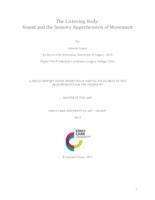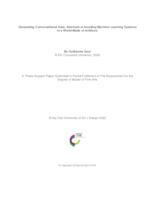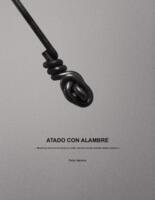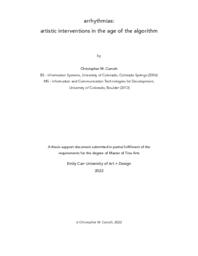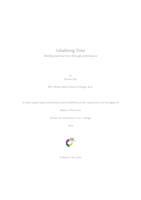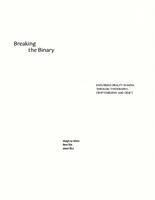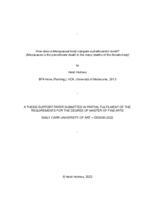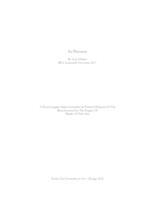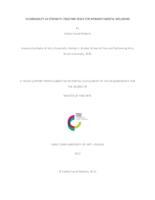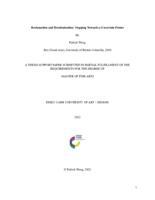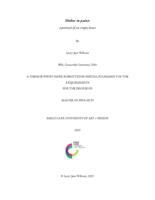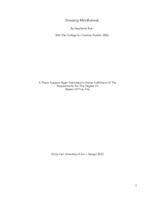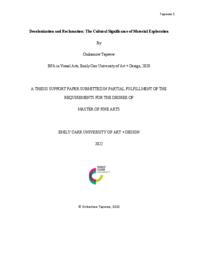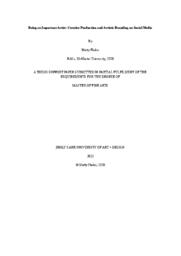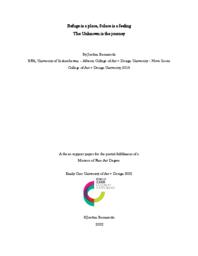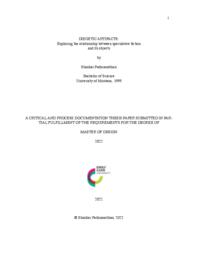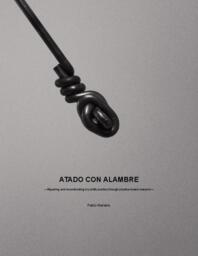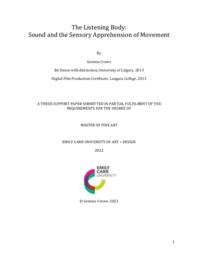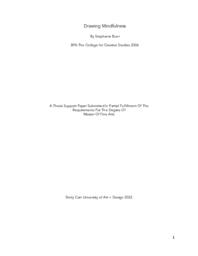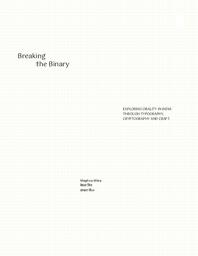Emily Carr University of Art and Design. Graduate Studies
Related Works
Content type
Compound Object
Description / Synopsis
Through the Master of Fine Arts program at Emily Carr University of Art + Design my work has focused on the mediated moving body as my research investigates the concept of embodiment for joy, self-awareness, and self-reflexivity. Art is an ideal vehicle to explore different ways of knowing, beyond cognition, by encouraging feeling through aesthetic affect. I came into the MFA program with professional experience in film and videography and a background in the performing arts, which influences how I approach an audience of viewers and listeners. A significant development to my practice has been the use of sound as material, working with its illusory potential, and depicting the presence of the moving body through experimental processes and makeshift sound installations. My thesis research is driven by a desire to understand, through experience; sensory perception, embodiment, the palpability of human presence through sound, and how to apprehend features of the world by listening and generating a felt sense of the physical body in space.
Origin Information
Content type
Compound Object
Description / Synopsis
This thesis support paper is about the journey of my development in art and illustration during the MFA program. The paper includes an introduction of my identity and background that is influential to my artistic practice. The focus of my practice centers around my experience as a Chinese immigrant in the west and the idea of the co-existence of eastern and western culture, identity, and ideology. I will introduce my artworks from the year 2016 to the most recent ones in chronological order to show how my works evolved over time. There will be an in-depth explanation about the techniques, creative intentions, and the concepts behind works, as well as a list of artists who inspired me visually and conceptually, and an analysis of their practice.
Origin Information
Content type
Compound Object
Description / Synopsis
The instrumentalization of biometric data orchestrated through surveillance technologies can press today’s users of communication tools, devices, and platforms to opt out of such systems. This graduate research thesis aims to reveal the imperceptible forces that underwrite recognition technologies, through a series of experiments and the creation of multimedia installations that address the unethical relationship between active users and structures of control. Initiated at Emily Carr University, Vancouver, from September 2020 to May 2022, this research project hopes to uncover new possibilities for machine learning systems to propose protective devices based on image datasets composed of theatrical masks. This project explores the potential to apply generative models simultaneously as a response to facial recognition technology and as a mode of resistance to the dominance of these models. Finally, this research contributes to raising awareness toward extractive systems and surveillance technologies, while questioning the impact of artificial intelligence and its potential future outcomes.
Origin Information
Content type
Compound Object
Description / Synopsis
This practice-based research addresses my crafts practice to redirect through design my professional activity as a woodworker and metalworker. The thesis documents and reflects on my work and findings over the course of a one-and-a-half-year process of engaging with reflective practice and practice-based research. The work approaches creative and expressive-related concerns through thematic forms, repetition, and reinterpretation, and inquiries about the affordances and distinct mindsets of designing and making through productive perspectives as contrasting as lo-fi hand-making and the use of digital means for designing and fabricating. The design outcomes range from small objects produced in domestic settings as part of weekly assignments, to months-long, self-driven projects producing big pieces of furniture at the shops in the university.
Origin Information
Content type
Digital Document
Origin Information
Content type
Compound Object
Description / Synopsis
The impulse at the center of my practice is simple: I am longing for time that stretches out. I do not wish to spend time, buy time, save time, kill time, keep time. I want to inhabit time. This paper is divided into four sections. In Entanglement, I reflect on the capitalist time structures I grew up within, and how they inform my positionality and practice. I chart my encounters with Zenji Dogen and Carlo Rovelli’s writing, whose ideas challenged my assumptions about time, and compelled me to search for time’s expansive layers. In Unravelling, I write about my material practice. It is through embodied observation of changing material processes that I first glimpse time that cannot be contained by the capitalist boundaries of hours and minutes. Here, I examine the elements and methods of a key durational performance – Maintenance in Progress. In Threads, I explore three layers of time – earth time, saeculum time and ritual time – that I have discovered within my practice. In this section, I discuss the film, Laying Ground, which will be screened at my thesis exhibition. Finally, in Weaving, I write about not knowing through a current project, Watering Cracks, and reflect on my expanded relationship with time. I do not dive into detailed examinations of capitalist time in this paper, though I recognize my entanglement with it. I want to experience the qualities of time that arise from the earth’s cycles, from embodied rituals and from the life-spans of my durational works themselves. I do not want to define my work in opposition to commodified, linear time. As I have discovered through my practice, different times exist not in tidy binaries, but as complex layers within which we are enfolded.
Origin Information
Content type
Compound Object
Description / Synopsis
This thesis explores the fluidity of language through the fusion of heterogenous visual traditions — creating hybrid forms and coded communication. It voyages through the linguistic landscape of India. Delving into its social, political and cultural identities it finds expression in typography, cryptography, craft arts and poetry. From this body of work emerged the hybrid typeface Latinagari, a character set that fuses the letterforms of the Devanagari and Latin scripts. Embodying both forms it is also neither. Being familiar to readers of either script, yet obscure. It both invites and denies the viewer’s desire to read. Representing the in-between spaces of spoken language in India, it is its own being. Through it, a novel graphic language finds form and with it new opportunities for expression, communication and mis-communication. Like the way Hindi flows to English and back in contemporary Indian culture this visual vocabulary becomes its own thing, An expression of identity, a linguistic code and a way of knowing.
Origin Information
Content type
Compound Object
Description / Synopsis
This research began with the body, however nobody (no-body) is the location where this practice presently exists. To be clear, this research is developed through symptoms that develop within a body and then exist outside of a body as material. Currently, these symptom-materials are formed by the conditions of Menopause. Formerly, these symptom-materials were determined by annals of failing fertility.
Origin Information
Content type
Compound Object
Description / Synopsis
This thesis document outlines several bodies of work that exist along a continuum of ongoing material process. In thinking through different sets of work, I seek to find through lines and consider past ways of making and thinking. In so doing, I hope to reaffirm to the reader, and to myself, the importance of patience, of attending and responding to one’s surroundings while knowing that the movement of process will be towards ever more resonant forms of making.
Origin Information
Content type
Compound Object
Description / Synopsis
In this thesis, I demonstrate how I map out my autobiographical experiences within my art practice to bring attention to the powerful capitalist and patriarchal structures that keep feminism, mental illness, and pain hidden. By using autotheory, I reflect on my life experiences and relate them to historical context and contemporary conditions to create a space that sheds light on the gendered body, trauma, and their stigmas. We currently live in a world that is going through a care crisis—a crisis of compassion—where having a powerful status is prioritized over empathy and love. I have situated my art practice as a way to explore, reflect, and share my own lived experiences under power’s carelessness. Documenting my personal, physical, and emotional experiences to gather this data are essential to my studio practice and research. As a woman who has been diagnosed with anxiety, depression, and suicidal ideation, I know first-hand, what this patriarchal and capitalist society thinks of mental illness. As a woman who has experienced trauma and pain, I know first-hand, how this patriarchal and capitalist society hides pain. As a woman, I know first-hand what this patriarchal and capitalist society thinks and expects of me. In short, this thesis is about my experiences, my journey, and my beliefs of the importance of talking about the things that are usually kept hidden from view. This project aims to create a space for care and for self-care.
Origin Information
Content type
Compound Object
Description / Synopsis
This thesis investigates the difficulties of reclamation and decolonization within the context of Hong Kong, recognizing the fluidity of how decolonization is defined, and the transitional nature of both people and place. Through printmaking and the metaphor of the Chinese squatting body, the artist examines how the squatting body can embody the transitional and transformational qualities of Hong Kong that express the hybridity and complexity of Hong Kong’s identity and colonial history. By combining Frantz Fanon’s definition of decolonization and Chantal Mouffe’s agonistic model, the artist argues that there is potential for political discourse within the space of Hong Kong to be resolved without enforcing a friend/enemy relationship, which often escalates towards violence, which is seen through the 2019-2020 protests. This research also shows the potential issues that may prevent the decolonization of Hong Kong due to the inherent conflict between Hong Kong’s identity as a part of the British colony, and its identity as a part of China.
Origin Information
Content type
Compound Object
Description / Synopsis
"Shelter in Paint: a portrait of an empty house" is an investigation into private space and private thought through the visual language of representational painting. Structured as though moving through the rooms of the house, this paper discusses different thematics of domestic space in response to a painting created throughout the course of this degree. It considers the entrance for the concept of interiority, the foundation as the history of interior art, vacant corners as spaces for daydreaming, domestic objects as portraits of the inhabitant, the neighbourhood in relation to public space, the kitchen as the domestic core, the bedroom for intimacy, and the attic for secrets and privacy. These parallels between psychological space and physical space attempt to answer research questions related to the emotional power of interior space, the rift between public and private life, and the ability of interior space to reveal to the inhabitant.
Origin Information
Content type
Digital Document
Origin Information
Content type
Digital Document
Origin Information
Content type
Digital Document
Origin Information
Content type
Digital Document
Origin Information
Content type
Digital Document
Origin Information
Content type
Digital Document
Origin Information
Content type
Digital Document
Origin Information
Content type
Digital Document
Origin Information
Content type
Digital Document
Origin Information
Content type
Digital Document
Origin Information

